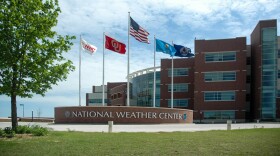More than 250 volunteers collected temperature and air quality data around Oklahoma City through a community science project in August to study the urban heat island effect.
Heat islands happen when certain areas in a city experience higher temperatures than the suburbs or rural areas nearby. According to the National Oceanic and Atmospheric Administration, neighborhoods with fewer trees than pavement and buildings can be up to twenty degrees hotter than nearby areas that have more trees and greenery.
The heat mapping project is funded by NOAA, and spearheaded by Climate Adaption Planning and Analytics Heat Watch (CAPA) and local organizations. The project has been active since 2017 to collect data on how parking lots and buildings can amplify the impacts of extreme heat while bringing awareness to the uneven distribution of greenspaces in cities.
Sarah Terry-Cobo is the associate planner for Oklahoma City’s Office of Sustainability. She led this year’s campaign in Oklahoma City, in partnership with OU, OKC Beautiful, and other environmental organizations.
Terry-Cobo said the urban heat island effect impacts areas of Oklahoma where there is an uneven distribution of trees. These areas she said tend to be historically redlined.
“There's definitely a swath kind of going pointing northeast east of Interstate 35 where you've got more trees, but that's in areas that are undeveloped,” she said. “That's not necessarily in some of the neighborhoods, because on the northeast side of town and the east side in general is historically redlined.”
The weather was less than favorable for a community-driven project that maps the urban heat island effect in Oklahoma City. Volunteers walked around the city and drove in their cars to collect data on heat and air quality.
It was a rare, cooler day in August. Temperatures hovered around 87 degrees, and it was cloudy and rainy most of the day.
But the rain didn’t discourage Terry-Cobo and the volunteers from collecting thermal images and air quality data by foot and by car. Terry-Cobo woke up at 4 a.m. to get the heat mapping campaign started for the day.
“Heat islands — and it’s totally raining, makes for great radio huh? It's really unusual for late August for it to be raining like this. We do all the planning, we do everything that we can, but we can't control the weather, so we just have to go with it,” she said.

Terry-Cobo pulled out her phone to take images of parking lots, sidewalks, and even the OKC street car using a consumer-grade thermal imaging device attached to her iPhone.
She’s surprised by the temperature differences between the concrete sidewalk and the prairie habitat at Myriad Botanical Gardens. Places that were cooler showed up as purple and blue, while hotter places were orange, yellow, and red.
“Oh, look at this. I just love the contrast,” she said as the phone changed from purple and blue on the habitat to orange, yellow, and red, on the sidewalk.
“The sidewalk at 92 degrees, 93 degrees. And then this tree at 85. So what we're seeing right now in the Myriad Gardens is a great example of a potential cooling strategy for urban heat islands,” she said.
The rain continued throughout the day. Thunderstorms rolled into the afternoon when Hongwan Li, an assistant professor in the College of Public Health at OU, her daughter, and Aimee Matland-Dixon, a PhD student at OU's School of Meteorology, picked up their equipment from Pitts Recreation Center.

Li said the community-driven aspect of this heat mapping campaign is what’s most important.
“This is a very, like, street or community science. Everyone can be a street scientist. Install this in the car and measure the air quality and the heat stress,” she said. “If we want to take a deeper look for the heat stress like in our communities, community-based is the most appropriate way to understand the heat stress better.”
Joey Williams is the project manager at CAPA. He said involving the community in this kind of work as a scientist provides CAPA with ground-level information satellites can’t pick up, brings awareness to the impacts of extreme heat, and gives people an opportunity to take action.
“Getting the community involved brings this degree of civic legitimacy to the data. It's not just coming from the sky. So people are able to vouch for the data they collected, they're involved in the process, and they're more invested in the output,” he said.
The average temperature for August across the U.S. was 2.3 degrees above average. It ranks as the ninth-warmest August in the nearly 130 years of recorded data.

Terry-Cobo said 4% of Oklahoma City’s 621 square miles is parking lots.
One thing she hopes this data could help with is to show the impact parking lots can have on the neighborhoods near them and lead to changes to the required amount of parking spaces per business.
“The other great part about this research and the expanded funding that we receive from our partners allows us to do what's called a jurisdictional scan and an intervention guidebook,” she said. “And so that will kind of identify, oh, if there is a particular law that stands in the way of us getting rid of parking minimums.”
Once the data is processed, the intervention guidebook could provide a roadmap for the city to tackle solutions to extreme heat. Solutions like where to plant more trees, restoring natural habitat, and installing cooling shelters and enclosed bus stops.
CAPA said the results of the project should be ready by late October or mid-November.
StateImpact Oklahoma is a partnership of Oklahoma’s public radio stations which relies on contributions from readers and listeners to fulfill its mission of public service to Oklahoma and beyond. Donate online.









